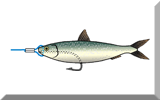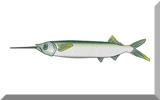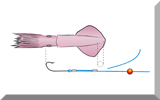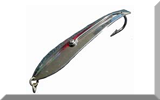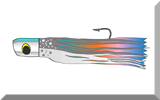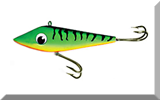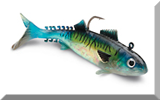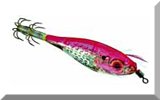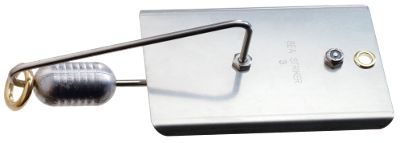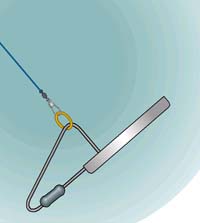Downrigger Planers - How They Work and How to Use Them
Neat devices, downrigger planers. They use the force of the water to drag your trolling lines deeper, unlike heavy lead downrigger weights which rely on gravity alone.
Planers come in several sizes, the smaller ones for low speed trolling with small lures, and the larger ones for, well yes, you've guessed it - faster tow speeds and larger lures.
They're an alternative to heavy downrigger weights - those spherical, finned devices weighing upwards of 10lb.
If you, like me, do most of your trolling from a sailboat, my guess is that you'll go for the much lighter and easier to stow planers.
However for power-boaters, who stay upright most of the time, then you may decide otherwise - and probably will, particularly if your boat's equipped with an electric downrigger.
How do Planers Work?
To understand this, we should take a look at their two main elements - the plate and the bridle:~
To understand this, we should take a look at their two main elements - the plate and the bridle/counterweight assembly as seen on the Downrigger Planers shown here on the right. shown here on the right.
The Plate
As the downrigger planer is drawn though the water a force is generated on the top surface of the rectangular stainless steel plate which drives it downwards.
The hole on the trailing edge of the planer is for connecting a quick-release clip for your trolling line.
Generally speaking, the greater the area of the plate and the faster the trolling speed, the deeper the downrigger planer will dive - but more on this a little further on.
The Bridle/Counterweight Assembly
The bridle (the metal bar) serves two purposes:~
- It supports the lead counterbalance ahead of the plate. The counterbalance weight is there to pull the leading edge of the plate down at the correct angle of attack for the water flow to exert a downward force on the plate.This is a vital part of the planer's design, as if the angle is either to steep or too shallow the planer will stall and spin.
- The bar also carries the attachment ring for the downrigger line, which is free to slide along it. In dive mode, as shown here, the attachment ring sits in the bend above the plate, allowing the counterbalance to do what counterbalances do.
When a fish strikes, this happy state of equilibrium is disturbed - the quick-release clip lets go, but not before the planer balance is upset, the attachment ring relocates itself at the sharp bend at counterbalance leaving the planer dangling uselessly. All downward force is now a thing of the past until it's re-set.
In this 'tripped' position the planer can be recovered easily ready for re-attachment to the trolling line when required.
Tripping and Re-Setting the Planer
If the planer didn't trip itself, it will strongly resist being hauled physically to the surface. To trip it manually, just pull in a few feet of line - and let go. It might take a few attempts, but it does work.
To re-set it, repeat the pull-in/let-go process.
But here's a valuable tip ...
Click here to find out how to re-deploy your trolling line without having to first retrieve your downrigger planer.
How Deep can Planers Get?
The depth to which a planer dives depends on the area of the plate, the speed of the tow and the length of the planer line.
As a general rule of thumb, you can expect around 15ft (5m) of depth for each 30ft (10m) of planer line deployed.
Theoretically, for any given size of planer and constant towing speed, the more planer line you let out the deeper the planer will dive.
So if letting out 20m of line gets you down 10m then 40m will get you twice that depth. Ah, no. Sadly, the law of diminishing returns says that it won?'t. The more line out, the greater becomes the line drag, which lowers the planer?s angle of attack and eventually trips it.
The optimum distance/depth relationship ultimately depends on the diameter and density of the planer line, and can only be properly assessed by trial and error.
Using Planers with Offshore Trolling Handlines
Planers aren't only for use with downrigger gear - they're ideal for offshore trolling handlines too, when you want to get your lure down deeper.
Always attach them well ahead of the lure, so that they don't spook the fish - a 30ft (10m) leader isn't excessive.
Attach the leader to the hole on the rear edge of the planer with a snap swivel.
Use either a largish trolling spoon, or a sinking diving plug - particularly those with internal rattling beads and an aggressive action. |
